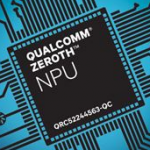 Bringing artificial intelligence to mobile computing is a significant challenge. That's the goal of Qualcomm's new Zeroth Processors.
Bringing artificial intelligence to mobile computing is a significant challenge. That's the goal of Qualcomm's new Zeroth Processors.
Mimicking the human nervous system and brain to allow computers to learn about their environment and modify their behavior based on this information has long been the goal of artificial neural networks. Whatever computing model is used to achieve this capability the real problem is one of scale. The human brain is estimated to have 100 billion neurons -- with 100 trillion connections. That is at least 1,000 times the number of stars in our galaxy.
These computational models can be implemented in software (e.g. Grok), but the ability to scale to the levels required for even simple human-like interactions is severely limited by conventional computing platforms. The Zeroth Neural Processing Unit (NPU) is a hardware implementation of the brain's spiking neural networks (SNN) method of information transmission. Integrating the NPU into computing platforms at the chip level would begin to address the computational and power requirements for these types of applications.
The goals of the Zeroth* platform are:
- Biologically Inspired Learning
- Enable Devices To See and Perceive the World as Humans Do
- Creation and definition of an Neural Processing Unit—NPU
Achieving "human-like interaction and behavior" is an ambitious goal, but it seems like this is a good first step.
UPDATE (25-Oct-13): Good overview here: Chips 'Inspired' By The Brain Could Be Computing's Next Big Thing.
UPDATE (1-Jan-14): CES 2014: Intel launches RealSense brand, aims to interface with your brain in the long run
___________
* The name Zeroth comes from the science fiction Three Laws of Robotics. The First law was that "A robot may not harm a human being."
Asimov once added a "Zeroth Law"—so named to continue the pattern where lower-numbered laws supersede the higher-numbered laws—stating that a robot must not harm humanity.
We'll have to wait and see, but let's hope so!
